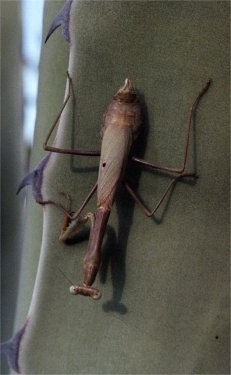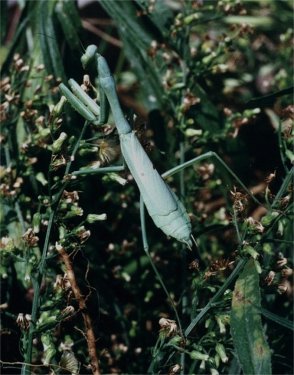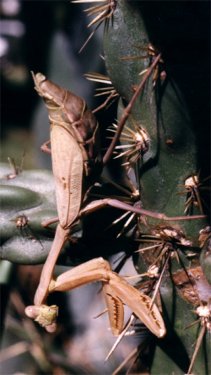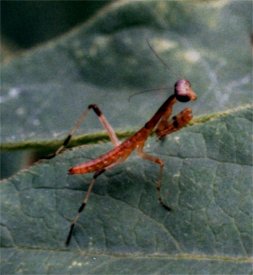Praying Mantis
by Valerie (September 2, 2000)
revised May 3, 2006


Mantises occur throughout our yard and garden, but seem to prefer the sunny xeriscape areas in the front yard. I often see them on the agaves and chollas, and find egg cases on the Jerusalem thorn trees. The most commonly seen praying mantises in this area come in various shades of brown and green. They are all the same species: Carolina Mantid (Stagmomantis carolina). With the huge range of size from baby to adult, as well as sexual dimorphism, there is plenty of room for variation. On all the adult insects, the wing coverings resemble leaves, either brown or green, with a little hole in them for realism. Toward the end of summer, the females' abdomens are often very large with eggs. While the females have small wings and cannot fly, males are capable of flying and their wings extend beyond the end of the abdomen
When the babies are born, they scatter quite quickly, since they are cannibalistic, and need to find territories in which to hunt. They are all a light brown color, with black stripes on their legs. They're awfully cute.
Like other predators such as spiders, the mantises like to hang out around flowering plants, where they are likely to be able to ambush nectar-seeking insects. They also tend to stay away from the ground, preferring tall flowers, shrubs and trees. I find them equally in either an upside-down position or right-side up, and although brown insects are usually on brown plants, and green on green, they do mix at times. While I've never had the privilege of watching praying mantises copulate, it is known that the female sometimes eats the head of the male while they are still mating. Theories on why they do this include sheer cannibalism by the larger female, extra nutrition for the developing eggs, and that, by removing the male's head, his body will continue to mate longer, thus ensuring fertilization. |


